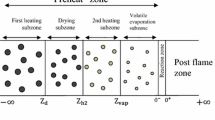Abstract
In this work, an analytical model is presented to simulate the combustion process of organic dust with considering radiative heat loss effect in counterflow configuration. A thermal model has been generated to estimate the flame propagation speed in various dust concentrations. The structure of premixed flame in a symmetric configuration, containing uniformly distributed volatile fuel particles, with nonunity Lewis number is examined with strain rate issue. The flame structure is divided into six zones: first heating, drying, second heating, volatile evaporation, reaction and post-flame zones. At first, the governing equations of lycopodium combustion dust particles are written for each zone. Finally, boundary conditions and matching conditions are applied for each zone in order to solve the differential equations. The purpose of this article is to analyze radiation heat transfer on lycopodium flame propagation dust particles and characteristics to check the effect of parameters on combustion.
Similar content being viewed by others
References
GOROSHIN S, TANG F D, HIGGINS A J, LEE J H S. Laminar dust flames in a reduced-gravity environment [J]. Journal of Acta Astronaut, 2011, 68(7, 8): 656–666.
DINCER I. Renewable and sustainable energy reviews renewable energy and sustainable development: A crucial review [J]. Journal of Renewable and Sustainable Energy Reviews, 2000, 4(2): 157–175.
WILLIAMS F A. Combustion theory [M]. Redwood City: Addison-Wesley, 1985.
LIPINSKI W, THOMMEN D, STEINFELD A. Unsteady radiative heat transfer within a suspension of ZnO particles undergoing thermal dissociation [J]. Journal of Chemical Engineering Science, 2006, 61(21): 7029–7035.
ANDERSSON K, JOHANSSON R, HJÄRTSTAM S, JOHNSSON F, LECKNER B. Radiation intensity of lignite fired oxy-fuel flames [J]. Journal of Experimental Thermal and Fluid Science, 2008, 33(1): 67–76.
PAUL S C, PAUL M C. Radiative heat transfer during turbulent combustion [J]. Journal of International Communications in Heat and Mass Transfer, 2010, 37(1): 1–6.
BIDABADI M, ESMAEILNEJAD A. An analytical model for predicting counterflow flame propagation through premixed dust micro particles with radiative heat loss [J]. Journal of Loss Prevention in the Process Industries, 2015, 35: 182–199.
PROUST C. A few fundamental aspects about ignition and flame propagation in dust clouds [J]. Journal of Loss Prevention in the Process Industries, 2006, 19(2, 3): 104–120.
PROUST C. Flame propagation and combustion in some dust-air mixtures [J]. Journal of Loss Prevention in the Process Industries, 2006, 19(1): 89–100.
SESHARDI K, BERLAD A L, TANGIRALA V. The structure of premixed particle cloud flames [J]. Journal of Combustion and Flame, 1992, 89(3, 4): 333–342.
BIDABADI M, AMERI N A H, MOSTAFAVI A. Thermo-phoresis effect on volatile particle concentration in micro-organic dust flame [J]. Journal of Powder Technol, 2012, 217: 69–76.
MODEST M F. Radiative heat transfer [M]. New York: McGraw-Hill, 1993.
BIDABADI M, HAGHIRI A, RAHBARI A. The effect of Lewis and Damkohler numbers on the flame propagation through micro-organic dust particles [J]. Journal of Thermal Sciences, 2010, 49(3): 534–542.
ROCKWELL S R, RANGWALA A S. Modeling of dust air flames [J]. Journal of Fire Safety, 2013, 59: 22–29.
Author information
Authors and Affiliations
Corresponding author
Rights and permissions
About this article
Cite this article
Bidabadi, M., Ebrahimi, F. & Bordbar, V. Modeling multi regional counter flow combustion of lycopodium dust cloud with considering radiative heat loss. J. Cent. South Univ. 24, 2638–2648 (2017). https://doi.org/10.1007/s11771-017-3677-4
Received:
Accepted:
Published:
Issue Date:
DOI: https://doi.org/10.1007/s11771-017-3677-4



